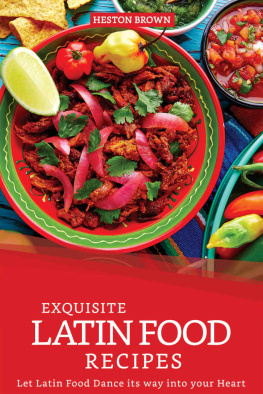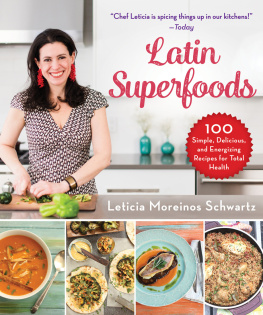St. Martins Press  New York
New York
The author and publisher have provided this e-book to you for your personal use only. You may not make this e-book publicly available in any way. Copyright infringement is against the law. If you believe the copy of this e-book you are reading infringes on the authors copyright, please notify the publisher at: http://us.macmillanusa.com/piracy.
Living in Miami helped immensely in the making of this book, as it is a microcosm of Latin and Caribbean cultures. Many people who helped me are named, yet there are many more unnamed folks who helped in some small way or anothermuchas gracias! Certain people who helped make this book possible deserve special mention. Most of all, my friend and husband, Joel Weltman, who was my constant companion on adventures to Latin and Caribbean markets, and who always encouraged me and helped sample my recipes. Much thanks to my friend and mentor, Kathy Martin at the Miami Herald, who not only believed in this book but also induced me to start a column called The Ethnic Explorer to share my extensive knowledge of south Floridas multiethnic grocery stores. Special thanks to Eva Lewitus in Lima, Peru, and to Trudi Langendorf for introducing me to her. Extra thanks to my dear friend Roberto Requea in Chicago, my sister Sharon Bladholm, my brother Eric Bladholm, and my wonderful mother-in-law, Freda Weltman.
Many thanks to all the patient and helpful Miami and Broward Latin and Caribbean market and restaurant owners and employees, including Ravi and Seeta Bedessee of East West Indian Foods; Jame Avando, Carmen, and Marybelle of El Chalan; Dariel Carvallo of Mexico Market; Angela Malbran of Pamelas Chilean Deli; Claudia Niera of Sabores Chilenos, Maria Tassi of Venezuelan European Corner; Joaquim Bras of Moises Bakery; Alex Petkovitch of Los Guachitos; Nachir Gil of Colombian Los Balkanes; Teresa San Martin and Sara Trimino of Panderia los Guaduales; Ricardo and Yolanda Rivera of Souveniles de Puerto Rico, George Bloomfield of Island Restaurant; Samuel and Fabia Jack and Sister Providentia Gboelusi of Sams Place, Segundo; Felicita and Jessica Lee of Chifa Chinese Restaurant; Reinaldo Bermudez and his niece Elietter Bermudez of Palacido de los Jugos; Fabrice Rivra of La Autentica Foods; Cesar Macedo of Las Americas News; Mario Graziano of Carniceria Argentina; Hebert Rocha of Brazilian Food Market, Joao Pietrowicz of Brasil Original; Joe Menezes of Via Brazil; Eduardo Lopera of Arco Iris, Lidia and Carlos Martinez of Las Vasca; Hassan, Mike, and Richard of Latin American Supermarket, and the Art Deco Market in Miami Beach. More thanks to Don and Katie Chafin, the Miami Beach Library, Professor Dario Moerno, Luis De Rosa, Jeanette Clark, Alan Kaufman, Steve OHair, Victor Silvas, Vivian Carballo, Lydia Martin, Patty Shillington, Pedro and Theresa Maia, Andrew Miller, Rene Howell-Miller, Diane Spivey, Susana Bellido, Chris Rollins of the Fruit and Spice Park in Homestead, Kristen Davis of Echo agricultural resources, and Lisa Kloak for bringing Fred into my life.
In Chicago, I would like to thank Jorge and Cindy Sanchez for the help, the music, and the wine; the Wallner familyJoe, Liz, Sarah, and Carolyn; Adam and Denise Volpendesta of the Old World Market, the biggest Afro-Caribbean market in the country, and the stores manager, Andreas Hernandez; Tony Macias, Noe Garcia, and Leo Delgado of La Fruteria; Antonio of La Unica Foods; Edmund Okoli; Beata Siemazko; Peter Kardaras; Alex Castro of La Guadalupana of La Casa de la Masa supermercado; and Evelyn Thompson. Special thanks to Jayson Harrison and David Lintzenich, now in the Canary Islands.
In New York, much thanks to Victor Gonzalez; Nach Waxman; Marc, Eve, Ruby, and Red Zimmetbaum; Amanda Hesser; Patricio Osses, the Chilean fish guy; Paul Wenzel; Susan and Allen Gonzalez; Francois Anate of the West African Grocery; Abdoulaye Da from the Senegal Commission; Astrid Gallego of Ecuatoriana; and Raymond Hadley, Tracey, and Elliot.
In California, many thanks to Marc Novak, Karen Maish, Jennifer and Amanda Quinn, Joan Quinn, Lisa Heidel and John Culpepper, Bill Cheal and Jackie Walker, Tomita, Mark, and Tae Li Shimamoto, Debbie Puente, Cindy Mushet, and Willy Guillermo Veliz of Amazonas Natural Foods.
This book would not have come into being without Richard F. X. OConnor or the staff at Renaissance Media, including publisher Bill Hartley, my editor Amanda Pisani, Michael Dougherty, Lisa Lenthall, Arthur Morey, Michele Lanci-Altomare, Jens Hussey, Jesus Arellano, and Kimbria Hays. Thanks also to Maluvi Martin Kaesbeck, William Anderson, Gabriel Bolaffi, Barbara Ezell, Tom James, Chris Ho, Father David Caron, Nick Malgieri, Janice Finney, Mary Myslis, Joe Windley, Robin Kennedy, Barbara Gillman, Dan Jaffe, Joan Chrissos, Diana de la Torriente, the turtles, bears, mouse king, and Fred, the best cat in the world.
Latin and Caribbean cuisines are a sensational melding of tropical tastes with multicultural influences. A sizzling fiesta of hot, sweet, tangy, and spicy flavors dancing to a samba of salsas, citrus mojos, and aromatic herb-infused sauces tempered with creamy coconut, tart tamarind, and cooling fruits. The purpose of this book is to give anyone who wants to try cooking Latin food a blueprint to navigating the more than 60,000 Latin markets in America. With this guide in hand, you will be able to identify and use a variety of exciting ingredients. To locate your nearest Latin market, scan the Yellow Pages of your local phone book. Retailers may be listed under Grocers or Food, but smaller mom-and-pop places may not be listed at all. Customers find them by word of mouth. In large metropolitan areas, Latin markets may be listed in city guides. If youre interested in a particular countrys cuisine, staff at that countrys consulate may give you some leads as to where locals shop. When you visit a Latin restaurant, ask where you can find the food, or who supplies itsome may be right next to or very near a market. Many Latin basics are available by mail order and on the Web, but you miss the atmosphere, home-cooked snacks, and the experience of meeting people who will be glad to help you, and share their culture and recipe tips.
Should you be traveling to Mexico, South America, or the Caribbean, pack this book and use it to demystify the markets and menus you will encounter. The Latin groceries in the United States carry just about everything you will encounter abroad (although a market in Mexico City, Rio de Janeiro, or San Juan will have fresher tropical produce). Youll find the same baked goods, snacks, and sweets described in the ensuing pages. Let this book be your passport to culinary culture.
Two-thirds of all the foods we eat have their origin in pre-Columbian America. The Mayas, Aztecs, and Incas had highly developed agricultural systems long before Columbus arrived on the scene with the conquistadors hot on his heels.
It is hard to imagine European cooking without potatoes, tomatoes, corn, beans, peppers, chocolate, or vanillaall gifts brought from the New World. On the other hand, its hard to conceive of Latin American cuisine without the wheat, rice, beef, pork, cheese, citrus, grapes, olives, and almonds brought from the Old World. This cross-cultural exchange of foodstuffs and cooking methods created the present day larder found throughout Latin America and forever changed how and what we eat.













 New York
New York